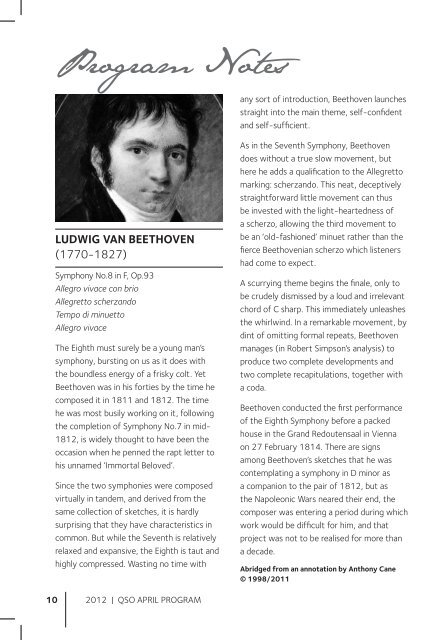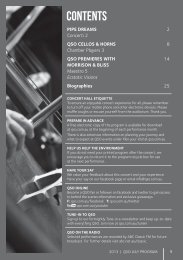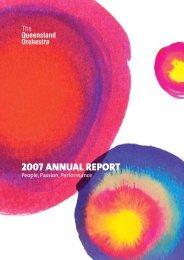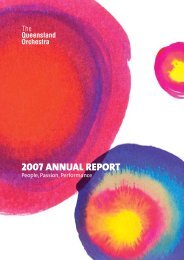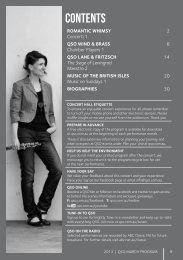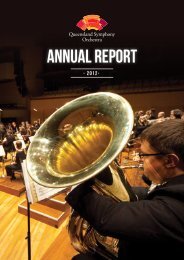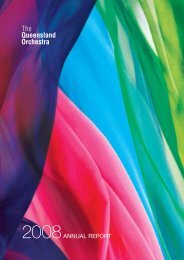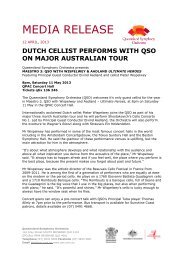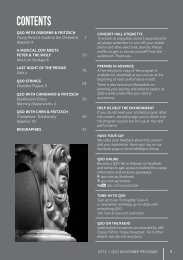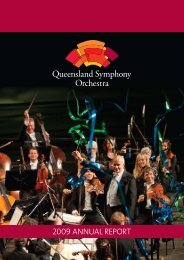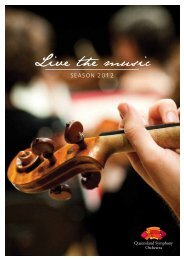April 2012 - Queensland Symphony Orchestra
April 2012 - Queensland Symphony Orchestra
April 2012 - Queensland Symphony Orchestra
Create successful ePaper yourself
Turn your PDF publications into a flip-book with our unique Google optimized e-Paper software.
Program Notes<br />
LUDWIG VAN BEETHOVEN<br />
(1770-1827)<br />
<strong>Symphony</strong> No.8 in F, Op.93<br />
Allegro vivace con brio<br />
Allegretto scherzando<br />
Tempo di minuetto<br />
Allegro vivace<br />
The Eighth must surely be a young man’s<br />
symphony, bursting on us as it does with<br />
the boundless energy of a frisky colt. Yet<br />
Beethoven was in his forties by the time he<br />
composed it in 1811 and 1812. The time<br />
he was most busily working on it, following<br />
the completion of <strong>Symphony</strong> No.7 in mid-<br />
1812, is widely thought to have been the<br />
occasion when he penned the rapt letter to<br />
his unnamed ‘Immortal Beloved’.<br />
Since the two symphonies were composed<br />
virtually in tandem, and derived from the<br />
same collection of sketches, it is hardly<br />
surprising that they have characteristics in<br />
common. But while the Seventh is relatively<br />
relaxed and expansive, the Eighth is taut and<br />
highly compressed. Wasting no time with<br />
any sort of introduction, Beethoven launches<br />
straight into the main theme, self-confident<br />
and self-sufficient.<br />
As in the Seventh <strong>Symphony</strong>, Beethoven<br />
does without a true slow movement, but<br />
here he adds a qualification to the Allegretto<br />
marking: scherzando. This neat, deceptively<br />
straightforward little movement can thus<br />
be invested with the light-heartedness of<br />
a scherzo, allowing the third movement to<br />
be an ‘old-fashioned’ minuet rather than the<br />
fierce Beethovenian scherzo which listeners<br />
had come to expect.<br />
A scurrying theme begins the finale, only to<br />
be crudely dismissed by a loud and irrelevant<br />
chord of C sharp. This immediately unleashes<br />
the whirlwind. In a remarkable movement, by<br />
dint of omitting formal repeats, Beethoven<br />
manages (in Robert Simpson’s analysis) to<br />
produce two complete developments and<br />
two complete recapitulations, together with<br />
a coda.<br />
Beethoven conducted the first performance<br />
of the Eighth <strong>Symphony</strong> before a packed<br />
house in the Grand Redoutensaal in Vienna<br />
on 27 February 1814. There are signs<br />
among Beethoven’s sketches that he was<br />
contemplating a symphony in D minor as<br />
a companion to the pair of 1812, but as<br />
the Napoleonic Wars neared their end, the<br />
composer was entering a period during which<br />
work would be difficult for him, and that<br />
project was not to be realised for more than<br />
a decade.<br />
Abridged from an annotation by Anthony Cane<br />
© 1998/2011<br />
WOLFGANG AMADEUS<br />
MOZART (1756-1791)<br />
Oboe Concerto in C, K.314<br />
Allegro aperto<br />
Adagio non troppo<br />
Rondo (Allegretto)<br />
Alexei Ogrintchouk, Oboe<br />
This concerto is more often heard, these<br />
days, played on the oboe, however for years<br />
it was known only as the Flute Concerto<br />
in D. Scholars were aware that Mozart, in<br />
1777, had composed a concerto for the<br />
oboist Ferlendis, who had recently joined the<br />
Salzburg Court <strong>Orchestra</strong>, but the work was<br />
thought to be lost.<br />
In 1920 Bernhard Paumgartner discovered<br />
in the Salzburg Mozarteum library a set of<br />
orchestral parts for a concerto in C major<br />
for oboe by Mozart, which was obviously an<br />
oboe version of his D major flute concerto.<br />
The familiar flute version had been prepared<br />
in 1778 to fulfil a commission for two flute<br />
concertos. Most probably Mozart had<br />
composed one (K.313) then, pressed for<br />
time, adapted the oboe concerto.<br />
The C major concerto is now central to the<br />
oboe repertoire. A deft and refined essay in<br />
the classical style, there are many ingenious<br />
and witty touches, such as the mock-serious<br />
cadence figure with repeated notes and a<br />
descending arpeggio which the soloist later<br />
extends. Donald Tovey finds opera buffa<br />
malice from the second violins, and tuttis<br />
crowded with contrapuntal and operatic life<br />
– typical Mozartian concerto writing, but<br />
never drawing attention to its skill.<br />
The second movement is mainly a lyrical<br />
cantilena for the soloist. A character in a<br />
later opera by Mozart gives the feeling of<br />
the Rondo: Blonde, the pert servant girl in<br />
The Abduction from the Seraglio, in whose<br />
aria Welche Wonne, welche Lust (Oh what<br />
pleasure, oh what joy!) Mozart returned to<br />
a variant of this rondo theme. In the second<br />
episode of the Rondo, first and second violins<br />
chase one another in a passage in threepart<br />
canonic counterpoint, worthy of the<br />
ingenuity of an improvising organist, and<br />
underpinned by a pedal note on the horns.<br />
Entertainment and the opportunity for<br />
virtuoso display is the keynote here.<br />
Abridged from an annotation by David Garrett<br />
© 2002<br />
10 <strong>2012</strong> | QSO APRIL PROGRAM <strong>2012</strong> | QSO APRIL PROGRAM 11


